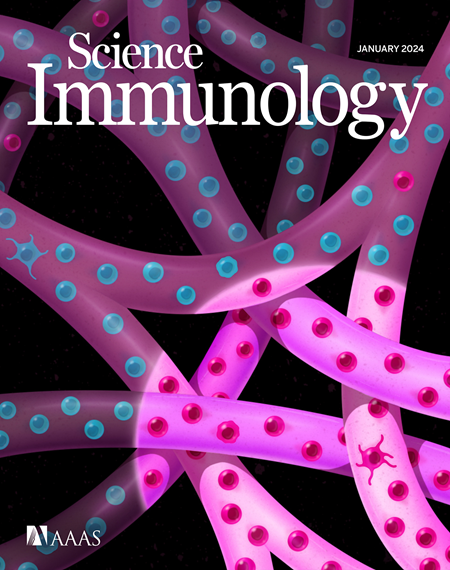天真 B 细胞对自发生殖中心的入侵迅速而持久
IF 17.6
1区 医学
Q1 IMMUNOLOGY
引用次数: 0
摘要
在由单个不听话的 B 细胞克隆引发的自身反应性生殖中心(GC)中,野生型 B 细胞会扩张并产生以其他自身抗原为靶点的克隆,这就是所谓的表位扩散。表位扩散的慢性、进行性特点要求早期干预以限制自身免疫性病变,但野生型 B 细胞入侵和参与 GC 的动力学和分子要求在很大程度上仍是未知的。通过在系统性红斑狼疮小鼠模型中采用同种异体移植和收养性转移方法,我们证明了野生型 B 细胞能迅速加入现有的 GC,进行克隆扩增、持续存在,并促进自身抗体的产生和多样化。野生型 B 细胞入侵自体反应性 GC 需要 TLR7、B 细胞受体特异性、抗原递呈和 I 型干扰素信号传导。收养性转移模型为确定自身免疫中B细胞耐受性破坏的早期事件提供了一种工具。本文章由计算机程序翻译,如有差异,请以英文原文为准。
Invasion of spontaneous germinal centers by naive B cells is rapid and persistent
In autoreactive germinal centers (GC) initiated by a single rogue B cell clone, wild-type B cells expand and give rise to clones that target other autoantigens, known as epitope spreading. The chronic, progressive nature of epitope spreading calls for early interventions to limit autoimmune pathologies, but the kinetics and molecular requirements for wild-type B cell invasion and participation in GC remain largely unknown. With parabiosis and adoptive transfer approaches in a murine model of systemic lupus erythematosus, we demonstrate that wild-type B cells join existing GCs rapidly, clonally expand, persist, and contribute to autoantibody production and diversification. The invasion of autoreactive GCs by wild-type B cells required TLR7, B cell receptor specificity, antigen presentation, and type I interferon signaling. The adoptive transfer model provides a tool for identifying early events in the breaking of B cell tolerance in autoimmunity.
求助全文
通过发布文献求助,成功后即可免费获取论文全文。
去求助
来源期刊

Science Immunology
Immunology and Microbiology-Immunology
CiteScore
32.90
自引率
2.00%
发文量
183
期刊介绍:
Science Immunology is a peer-reviewed journal that publishes original research articles in the field of immunology. The journal encourages the submission of research findings from all areas of immunology, including studies on innate and adaptive immunity, immune cell development and differentiation, immunogenomics, systems immunology, structural immunology, antigen presentation, immunometabolism, and mucosal immunology. Additionally, the journal covers research on immune contributions to health and disease, such as host defense, inflammation, cancer immunology, autoimmunity, allergy, transplantation, and immunodeficiency. Science Immunology maintains the same high-quality standard as other journals in the Science family and aims to facilitate understanding of the immune system by showcasing innovative advances in immunology research from all organisms and model systems, including humans.
 求助内容:
求助内容: 应助结果提醒方式:
应助结果提醒方式:


